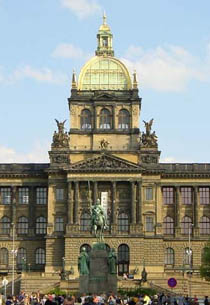
National Museum calls for a reconstruction with an alarming exhibition
 |
The contrast is made by everything that has recently fallen from the decaying museum - fragments of architectural elements and sculptural decorations, gilded decorations made of copper sheet torn off the roofs by the wind, crumbling pieces of slate from the roofing, destroyed windows, and dismantled original fittings. Photographs document the most damaged places of the building, which has been calling for renovation for decades.
"I would rather prepare more joyful exhibitions, but this one rightly unsettles visitors," said Lubomír Sršeň from the department of older Czech history before the opening. That is why the exhibition was titled What Lies Beneath the Gilding? The Neo-Renaissance building has been a monumental architectural crown of the center of Prague for 115 years, but also the most neglected building in Wenceslas Square. The building was damaged in May 1945 by an aerial bomb and in August 1968 by gunfire from Soviet soldiers. Twelve years later, due to the tunneling for the metro, the left front corner of the palace broke off. Since then, the museum has been squeezed on two sides by a busy north-south thoroughfare, which damages the building tectonically, climatically, communicatively, and aesthetically.
Furthermore, the museum palace has suffered from insufficient maintenance due to a low budget since World War II. According to General Director Michal Lukeš, utility networks may cease to function at any time, stone parts of cornices, balustrades, or sculptures may collapse onto the surrounding sidewalks. These risks threaten the collections, staff, and visitors. "For safety reasons, we had to remove the sculpture that was located above the visitor-exposed area of the main entrance to the building and was in a critical condition," he stated.
In addition to the mentioned risks, the building has many "normal defects". These include cracking slate tiles on the roofs, peeling exterior plaster, flimsy windows, and outdated, poor, and inefficient heating methods. Halls without air conditioning do not allow for the exhibition of collection items made of more sensitive materials.
A general reconstruction of the building will require a state grant of 4.5 billion crowns. Two things are clearer now - in March, deputies allowed the disbursement of one billion crowns from the National Property Fund for the museum's needs, which was also approved by the government. "Preparatory work will begin next year and will last until 2011, then it will be possible to proceed with the repairs, which must be connected to the state budget," said Lukeš to ČTK.
The problem is relocating millions of collection items. That is why the museum would like to use the adjacent building of the former Federal Assembly, where it would acquire, for example, 3,000 square meters of exhibition space for new exhibitions, build a branch library for 200,000 volumes, and relocate administrative operations there, which would free up a thousand square meters of exhibition space in the main building. Lukeš is optimistic, even though he knows it is music for the future.
The exhibition commissioner and deputy director Karel Ksandr considers the preparatory work and professionalism of the repairs to be important. A warning reminder is the poorly executed reconstruction of the museum ramp from the early 90s, where defects appeared after just twelve years.
"The general reconstruction should not be postponed or delayed. The progress in recent months has been significant, but the fight is definitely not over," added Lukeš.
The English translation is powered by AI tool. Switch to Czech to view the original text source.
0 comments
add comment









